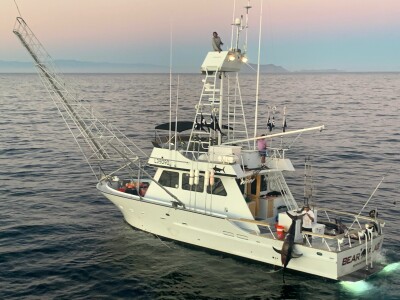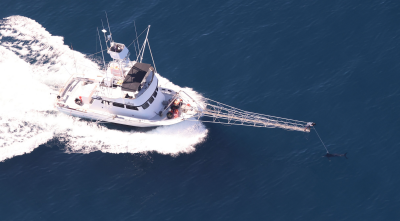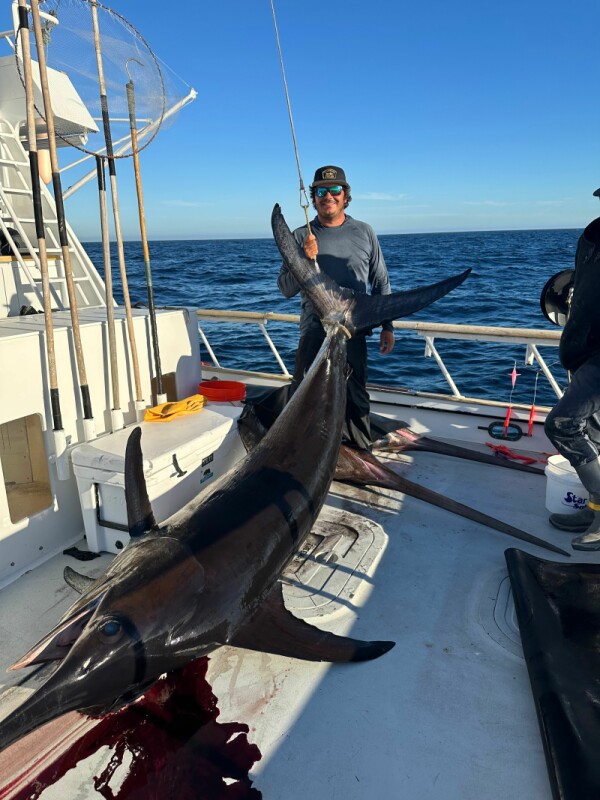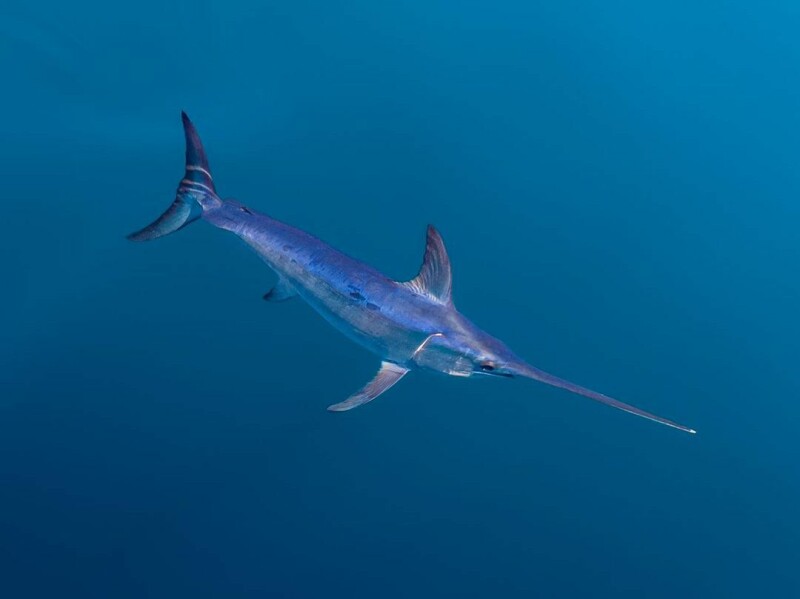After decades of public scrutiny, legal battles, and many regulatory changes that constricted the fishery, large-mesh drift gillnets for swordfish in California will be phased out by 2027. Deep-set buoy gear, now being employed under federal exempted fishing permits, is set to become the primary method to harvest swordfish off the California coast, with harpoons continuing as a supplemental fishery.
After years of debate and with plenty of bad blood some between primary stakeholders, there is one thing the fishing industry, fisheries managers, and environmental groups agree on: There will be less bycatch from catching swordfish, but unless new technology can be scaled up there will also be less swordfish landed out of California ports.
“It’s not a replacement fishery for large mesh drift gillnets,” says Chugey Sepulveda of deep-set buoy gear. Sepulveda is director and senior scientist at the Pfleger Institute of Environmental Research and is the person who first developed deep-set buoy gear in the Southern California Bight. The buoy gear “was brought online to capitalize/augment the existing harpoon fishery, which supports a market that receives a higher price-point for its catch.”
Deep-set buoy gear has shown to be effective at catching swordfish efficiently with minimal bycatch, yielding a higher market price per pound, but Sepulveda and fishermen currently using the gear under federal exempted fishing permits say it was developed for smaller boats and doesn’t yield the volume of fish needed to cover the costs of larger vessels.
Furthermore, bycatch was still part of the catch for drift gillnets. Fishermen using large mesh drift gillnets earned additional income from retained thresher shark, louver, and other species, that will be lost with deep-set buoy gear.
Deep-set buoy gear consists of a vertical mainline around 150 fathoms in length with a flagpole outfitted with a light or radar reflector at the surface and a heavy sinker to keep the line anchored vertically. Attached to the mainline are typically 1 to 3 circle hooks with a light attached to shine below the thermocline at 20-70 meters (65 to 230 feet) in California waters. The gear is also designed to be actively tended with strike indicators at the surface to alert fishermen when a fish is on.

Initial results for the deep-set buoy gear trials found that 92.4 percent of all fish landed were the target species, and 98 percent consisting of swordfish or another marketable species, according to NOAA Fisheries reports.
The highly migratory North Pacific swordfish, while still considered to be above target population levels by NOAA Fisheries, have not come to United States waters in large numbers in the past few years, causing both remaining large mesh drift gillnet and upstart deep-set buoy gear fishermen to suffer. Whether or not migrations return to southern California, the future will be different with the loss of a fishery whose heyday was in the late-1980s, but with openings for new markets and continued gear innovation.
The death knell of the embattled gear type came with the passage of the Driftnet Modernization and Bycatch Reduction Act, which was tucked into the 4,155-page and $1.7 federal spending bill in December. A federal ban was first passed by both chambers of Congress as a standalone bill in 2020 but was subject to the final veto of Donald Trump’s presidency.
The question of the merits of a federal ban aside, the slow death of large-mesh drift gillnets is exemplative of the uphill public-relations battle many U.S. fisheries face over impacts on protected species like whales, marine mammals, and sea turtles.
Environmental groups campaigned against drift gillnets as “walls of death” and created materials with images of drowned California sea lions, sharks, sea turtles and dolphins. This was a challenging message for the industry to counter, even as the fishery regularly met is federally set goals to reduce bycatch of protected species, especially from 2015-2019.
Yet, the fishery recorded two entanglements of humpback whales in the 2020-2021 and 2021-22 seasons with just 7 permits actively fishing, says Geoff Shester, Oceana’s California campaign director and senior scientist. Shester and his team at Oceana campaigned for the federal phase-out.
They reported that according to observer data for the 2021-2022 season, 92 marine mammals were snagged during that season, 87 of which were killed, equating to one marine mammal caught in large-mesh drift gillnets for every three swordfish landed. The environmental organization also took issue with low observer rates at 19.5 percent, well below the federal requirement of 100 percent coverage.
“We’re not trying to put fishing communities out of business, we want to see them thrive,” said Shester. “We want to scale up clean fishing technology so more fish can be caught as opposed to scaling down a dirty fishing method. This will be beneficial to everyone in the long run.”
While the campaigns for a complete ban on large mesh drift gillnets gained traction politically, the National Marine Fisheries Service (NMFS) pointed to the economic harm a phase-out would cause and to the fact bycatch in the fishery had reached its targeted reductions. In a congressional testimony in 2019 on an earlier incarnation of a federal phase out, deputy NOAA administrator Tim Gallaudet said the legislation “raises several concerns.” He continued to say based on 26 years of observer data, bycatch of protected species was a “rare event” and that NOAA was concerned switching to alternative gear was “not economically viable” and would reduce yields.

Before the twilight of the large mesh drift gillnets was set in motion in Washington D.C., the state of California had already acted to dramatically reshape the fishery, with 38 California commercial fishermen retiring their gillnets with a state buy-out plan, with many switching to deep-set buoy gear.
In 2018, the California legislature voted to terminate all drift gillnet permits by Jan. 31, 2024. The bill also established a transition program to help fishermen mitigate transition costs and develop new techniques to efficiently harvest swordfish efficiently with less bycatch. All told, $2.3 million in state funds and $1 million provided by Oceana, an environmental non-profit, have helped remove 50 miles and 54 tons of gillnets from the Pacific. Twenty-three fishermen with active permits received $110,000 in compensation, the remaining 15 with had inactive permits and received $10,000.
The West Coast large-mesh drift gillnets, around a mile in length, are set at around dusk and are hung at 200 feet below the ocean surface for up to 12-14 hours. Swordfish were harvested almost exclusively with harpoon in waters off the coast of California until 1980. But the fishery proved to be hit-or-miss with fishermen only able to harpoon swordfish at time when they are basking. So, fisherman began using large-mesh drift gillnet for a more predictable catch at which time the state of California began issuing permits.
Large-mesh drift gillnets are only allowed off the coast of California and Oregon, and are prohibited everywhere else in United States waters over environmental concerns. While the pelagic longlines used to harvest in Hawaii and the Atlantic Coast, they are federally prohibited on the West Coast. Looking globally, pelagic drift gillnets more than 20 miles in length have been banned in international waters by the United Nations since 1992, virtually ending their use on the high seas.
High bycatch rates of whales, sea turtles, and other marine mammals lead California voters passing a ballot measure to ban large-mesh drift gillnets in state waters and 1990 and lead to the creation of the federal take reduction team in 1996. In 2001, a Pacific Leatherback Conservation Area was established closing 213,000 square miles of lucrative fishing grounds north of Point Conception from August 15 to November 15 every year.
The fishery fell under federal management in 2004 with the Pacific Fishery Management Council’s Highly Migratory Species Plan, but it wasn’t until 2018 that the NOAA Fisheries issued federal permits to state permit holders.
The fishery had peaked in 1988 and 1989 with 10,000 sets made each year with more than 200 active permits, according to NOAA Fisheries. But in the 2020-21 and 2021-22 season just seven large-mesh drift gillnet permits—out of a total of 25 federal permits—were active.
“Swordfish should have been the third biggest producer in California behind squid and Dungeness crabs,” said Gary Burke, 76, of Santa Barbara, who has fished for swordfish with large-mesh drift gillnets since the 1980s and has remained one of the most vocal defenders of the fishery in the state. “As it is now there are so few boats left, we can’t do much marine mammal harm or ecological harm.”
While the 2018 California law terminates state large-mesh drift gillnet permits by 2024 and requires those accepted the buyout to rescind their federal permits, drift gillnetting would have been permitted for the 25 permit holders in federal waters off the coast of California in absence of the federal ban. The federal legislation also includes grants to the remaining large-drift gillnet permit holders to cover the cost of permits, the forfeiture of existing fishing gear, and the acquisition of alternative fishing gear, according to the Congressional Budget Office.
When the California buyout were offered, Burke stayed resolute in defense of drift gillnets.
“I didn’t take the buyout because to me it wasn’t worth it. One hundred grand for my livelihood? With the buoy gear it’s just not efficient enough to turn a profit,” he said. After the federal decision, Burke was non-committal on what he would do with the opportunity for a federal buyout, saying the fight might not be over. Others, who took the state buyout, still defended the fishery but said they were either tired of fighting or had personal circumstances, whether it be age or opportunity elsewhere.
Participants in the California buyout program might be in for an unwelcome surprise when the federal government issues its first tranche of up to 50 limited entry permits for deep-set buoy gear in the next year or so. It’s been widely reported that recipients of the state buyout recipients will be first in line for federal permits, but they’re not. They’re second in line to participants in the deep-set buoy gear EFP, according to the PFMC. With many EFP participants not being large mesh drift gillnet permit holders, there might not be enough limited entry permits to go around for all EFP participants and state buyout recipients.
Nathan Perez, 38, of Newport Beach, had purchased a large mesh drift gill net permit, but found himself running a boat, the 47-foot Bear Flag II, that was set up for deep-set buoy gear and wasn’t powered to haul a heavy drift net. “I got hired on to run a company boat and I had paid for a permit I’m not going to use for the next 15 years,” Perez said of his reasoning to take the buyout. “I don’t have anything against gillnet fishing — I enjoyed it and did it for a bunch of years.”
Perez notes that swordfish have been in short supply for everyone in recent years, but says there is promise for deep-set buoy gear for smaller and medium sized boats and they he’s even landed more on some trips than gillnetters.
James Heflin has fished for swordfish out of San Diego since the mid 1960s and participated in the state buyout program. As the owner and founder of Chula Seafood with a wholesale market in San Diego and three restaurants in nearly Arizona. Heflin calls the state buyout an “evolutionary deal.”
“We addressed the issues, but like so many of us you just get tired of going through the battle,” he says of the years of political wrangling over drift gillnets. There’s promise in deep-set buoy, but that depends on a stable premium market, he says. For his vessel, the 68-foot F/V Chula, deep-set buoy gear is “not economically profitable,” but notes as a larger vessel his operating costs are higher than most. He also purchases swordfish from other deep-set buoy gear operators.
Looking to the future Heflin has the optimism of one who isn’t just a catcher, but a marketer of fish.
“No bycatch…that’s why I love the deep set and the harpoon, the older I get the more I’m going to do this,” he says. “The California deep-set buoy gear fish is the best swordfish in the world. Period.”








